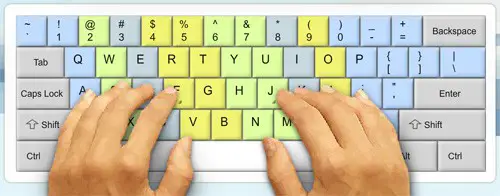


The important thing is not to look, even if they’re unsure.

To identify which keys may need a bit more practice, consider asking the student to type the alphabet into a word processing program such as MS Word. If a student struggles with any particular reach or combination of letters, try placing a small spot of Blu-tack or other sticky substance temporarily on the key or keys to make it easier to find by touch. Painting out the letters on the keyboard works, but is radical as it does ruin your keyboard for anyone who can’t touch type! Additional aids There are all sorts of covering options: rubber skins that fit over the keys themselves, metal or wood covers, DIY constructions using cereal boxes, a small hand towel or a sheet of paper taped at the back of the keyboard with masking tape - though some students dislike the feel of something touching the backs of their hands. Many typists have never noticed those two little bumps on F and J which help find the correct starting position by touch alone. It really brings home the importance of finger positioning. Some learners will find it fun to close their eyes to see if they can type a word, line or perhaps an entire module without peeking. With gentle, yet persistent encouragement to look at the screen rather than the keyboard, and perhaps with periodic tries at hand covering, almost all students will eventually raise their gaze permanently. You may find it helps them to watch their fingers via peripheral vision, as they build connections in the brain and develop their muscle memory.īeing too strict about hand covering especially for younger students, may lead to frustration and disenchantment. Quite often, students lack the physical awareness to instinctively "feel" where their fingers are moving to when they first learn to press the keys. However, it is for you to judge whether you feel this will actively help or hinder your individual students in the early stages of their TTRS journey. If you can't type very quickly with your own typing technique right now, the learning effort is definitely worthwhile.Many traditional typing programs will advocate the covering of hands right from the outset, to encourage touch-typing to develop more quickly. The time needed, which probably prevented you from learning to type with 10 fingers, can therefore be completely neglected in comparison to the possible long-term time saving. Depending on how fit you are on the keyboard at the moment, even a 3- to 4-fold increase in typing speed is possible - with correspondingly higher time savings. Of course, this is only an example calculation. Other ergonomic keyboards, due to arm position, finger strike angle, and switch design, seem to take twice the finger pressure and wrist contortions that. The key depressor is useful for pressing keys on computer keyboards, calculators, telephones and other items.
#Typing fingers hands free#
For a working week of 40 hours, this means 4 1/2 weeks of free time per year, which you can use for other tasks or which at least allows you to go to work on time much more often. The extension provide additional finger support. If you double your typing speed, you will save about 180 hours per year.

Projected to one year, that is already 365 hours. Let's assume you spend an average of 1 hour a day entering texts. The time we spend every day entering texts on the computer may vary according to our profession and private usage patterns and may not seem so much to us - but the long-term approach is decisive here. And also privately we spend more and more time in the digital world.
#Typing fingers hands professional#
Nowadays, 2/3 of all professional activities require work on the computer. Who is our offer actually intended for? And is it worthwhile for you to invest the time and learn to type "the right way"?


 0 kommentar(er)
0 kommentar(er)
